engine TOYOTA HIGHLANDER HYBRID 2012 XU40 / 2.G Manual Online
[x] Cancel search | Manufacturer: TOYOTA, Model Year: 2012, Model line: HIGHLANDER HYBRID, Model: TOYOTA HIGHLANDER HYBRID 2012 XU40 / 2.GPages: 636, PDF Size: 11.26 MB
Page 470 of 636
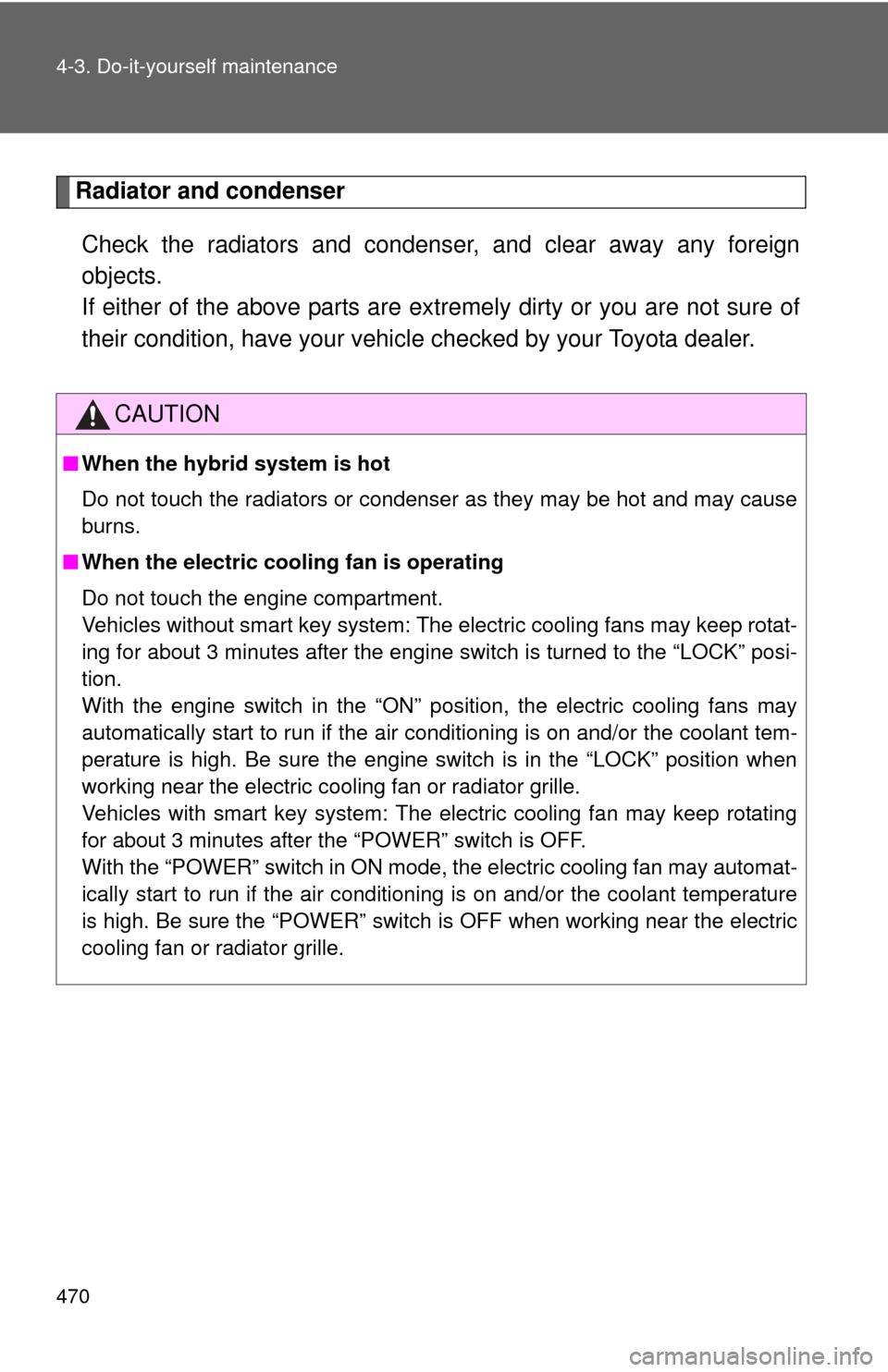
470 4-3. Do-it-yourself maintenance
Radiator and condenserCheck the radiators and condens er, and clear away any foreign
objects.
If either of the above parts are ex tremely dirty or you are not sure of
their condition, have your vehicl e checked by your Toyota dealer.
CAUTION
■When the hybrid system is hot
Do not touch the radiators or condenser as they may be hot and may cause
burns.
■ When the electric cooling fan is operating
Do not touch the engine compartment.
Vehicles without smart key system: The electric cooling fans may keep rotat-
ing for about 3 minutes after the engine switch is turned to the “LOCK” posi-
tion.
With the engine switch in the “ON” position, the electric cooling fans may
automatically start to run if the air conditioning is on and/or the coolant tem-
perature is high. Be sure the engine switch is in the “LOCK” position when
working near the electric cooling fan or radiator grille.
Vehicles with smart key system: The electric cooling fan may keep rotating
for about 3 minutes after the “POWER” switch is OFF.
With the “POWER” switch in ON mode, the electric cooling fan may automat-
ically start to run if the air conditioning is on and/or the coolant temperature
is high. Be sure the “POWER” switch is OFF when working near the electric
cooling fan or radiator grille.
Page 472 of 636

472 4-3. Do-it-yourself maintenance
Washer fluidAdd washer fluid in the following
situations.
●Any washer does not work.
● The warning message
appears on the multi-informa-
tion display. ( P. 538)
CAUTION
■When adding washer fluid
Do not add the washer fluid when the engine is hot or running, as the washer
fluid contains alcohol and may catch fire if spilled on the engine etc.
NOTICE
■Do not use any fluid other than washer fluid
Do not use soapy water or engine antifreeze instead of washer fluid.
Doing so may cause streaking on the vehicle’s painted surfaces.
■ Diluting washer fluid
Dilute washer fluid with water as necessary.
Refer to the freezing temperatures listed on the label of the washer fluid bot-
tle.
Page 491 of 636

491
4-3. Do-it-yourself maintenance
4
Maintenance and care
Air conditioning filter
The air conditioning filter must be changed regularly to maintain air
conditioning efficiency.
■ Removal method
Vehicles without smart key system: Turn the engine switch
OFF.
Vehicles with smart key system: Turn the “POWER” switch
OFF.
Open the glove box. Slide off
the damper.
Push each side of the glove
box to release the pins. Then
disconnect the claws at the
bottom and remove the glove
box.
Lift up the cover.
STEP1
STEP2
STEP3
STEP4
Page 497 of 636

497
4-3. Do-it-yourself maintenance
4
Maintenance and care
Checking and replacing fuses
If any of the electrical components do not operate, a fuse may have
blown. If this happens, check and replace the fuses as necessary.
Vehicles without smart key system: Turn the engine switch
OFF.
Vehicles with smart key system: Turn the “POWER” switch
OFF.
Open the fuse box cover.
Engine compartment (type A) Push the tab in and lift the lid
off.
Engine compartment (type B) Push the tab in and lift the lid
off.STEP1
STEP2
Page 498 of 636
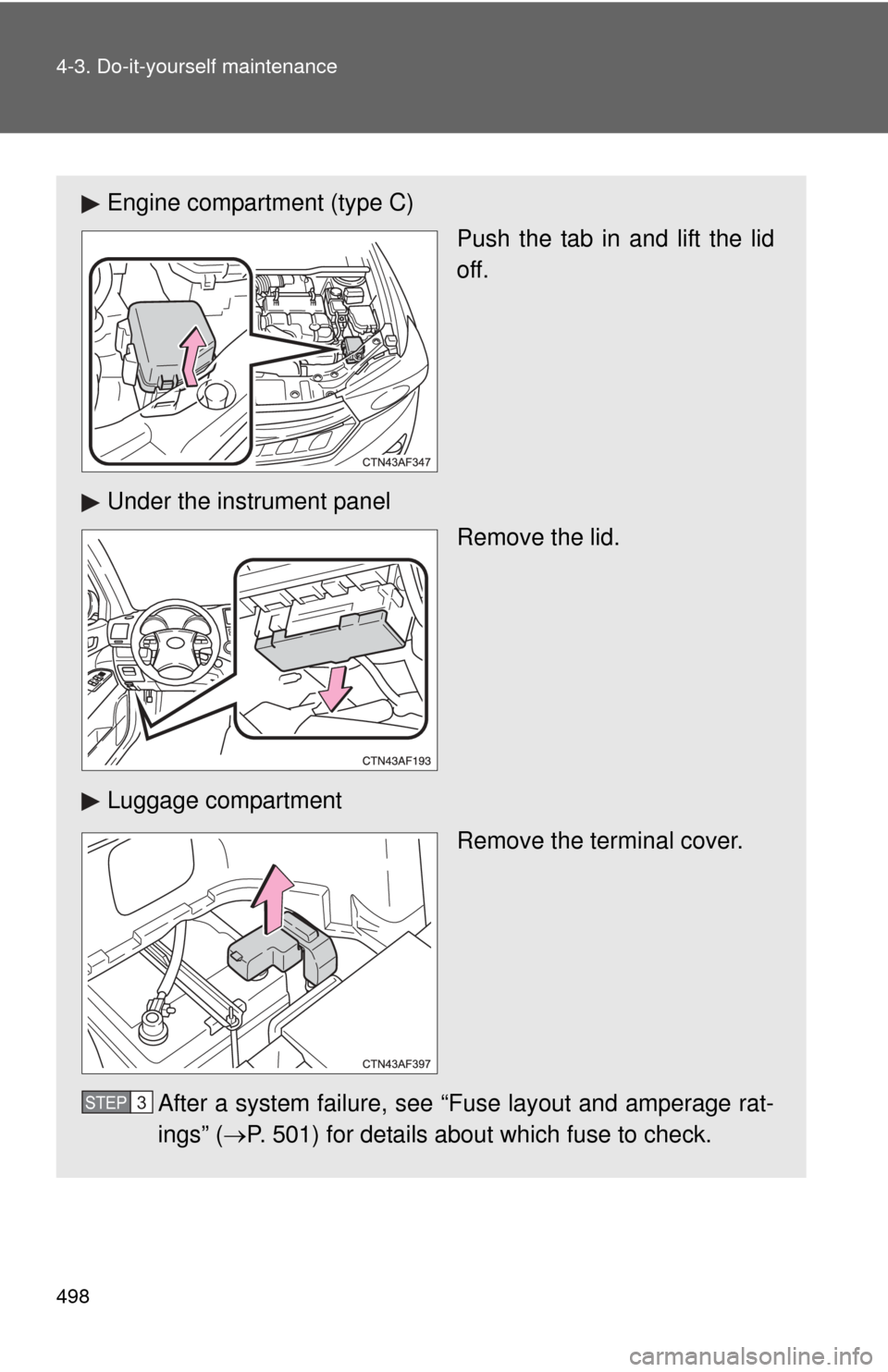
498 4-3. Do-it-yourself maintenance
Engine compartment (type C)Push the tab in and lift the lid
off.
Under the instrument panel Remove the lid.
Luggage compartment Remove the terminal cover.
After a system failure, see “Fuse layout and amperage rat-
ings” ( P. 501) for details about which fuse to check.
STEP3
Page 501 of 636
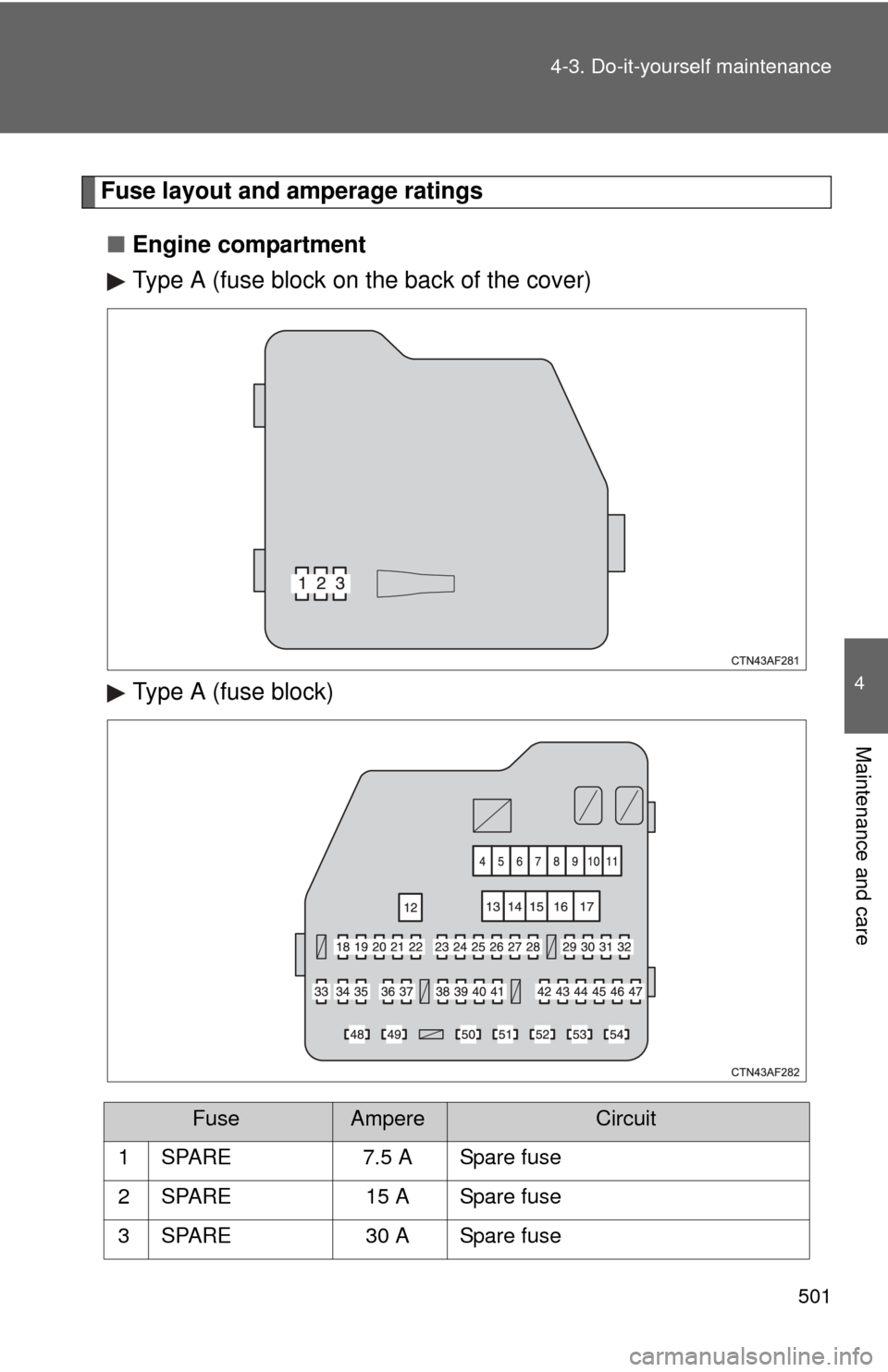
501
4-3. Do-it-yourself maintenance
4
Maintenance and care
Fuse layout and amperage ratings
■ Engine compartment
Type A (fuse block on t he back of the cover)
Type A (fuse block)
FuseAmpereCircuit
1 SPARE 7.5 A Spare fuse
2 SPARE 15 A Spare fuse
3 SPARE 30 A Spare fuse
Page 503 of 636

503
4-3. Do-it-yourself maintenance
4
Maintenance and care
20 ST
10 A Starting system
21 IG2 30 A INJ, GAUGE NO.2, IGN
22 STRG LOCK 20 A Steering lock system
23 RADIO NO.1 20 A Audio system
24 ABS MAIN
NO.3 15 AElectronically controlled brake sys-
tem
25 AMP 15 A Audio system
26 HAZ 15 A Turn signal lights
27 CAPACITER 15 A Brake system
28 G/H 10 AGlass hatch, multiplex communica-
tion system, outer foot lights
29 CRT 10 ARear seat entertainment system,
audio system
30 ETCS 15 AMultiport fuel injection system/
sequential multiport fuel injection
system
31 AM2 7.5 A Multiplex communication system
32 ECU-B NO.2 7.5 A Air conditioning system
33 HV MAIN 10 A Hybrid system
34 DOME 10 AVanity lights, personal lights, inte-
rior light, gauges and meters, door
courtesy lights, engine switch light
35 ECU-B NO.1 10 A Steering sensor, gauges and
meters, main body ECU, wireless
remote control, smart key system,
power back door, on-board diagno-
sis system, multi-information dis-
play
36 EFI NO.1 10 AMultiport fuel injection system/
sequential multiport fuel injection
system, smart key system
FuseAmpereCircuit
Page 522 of 636
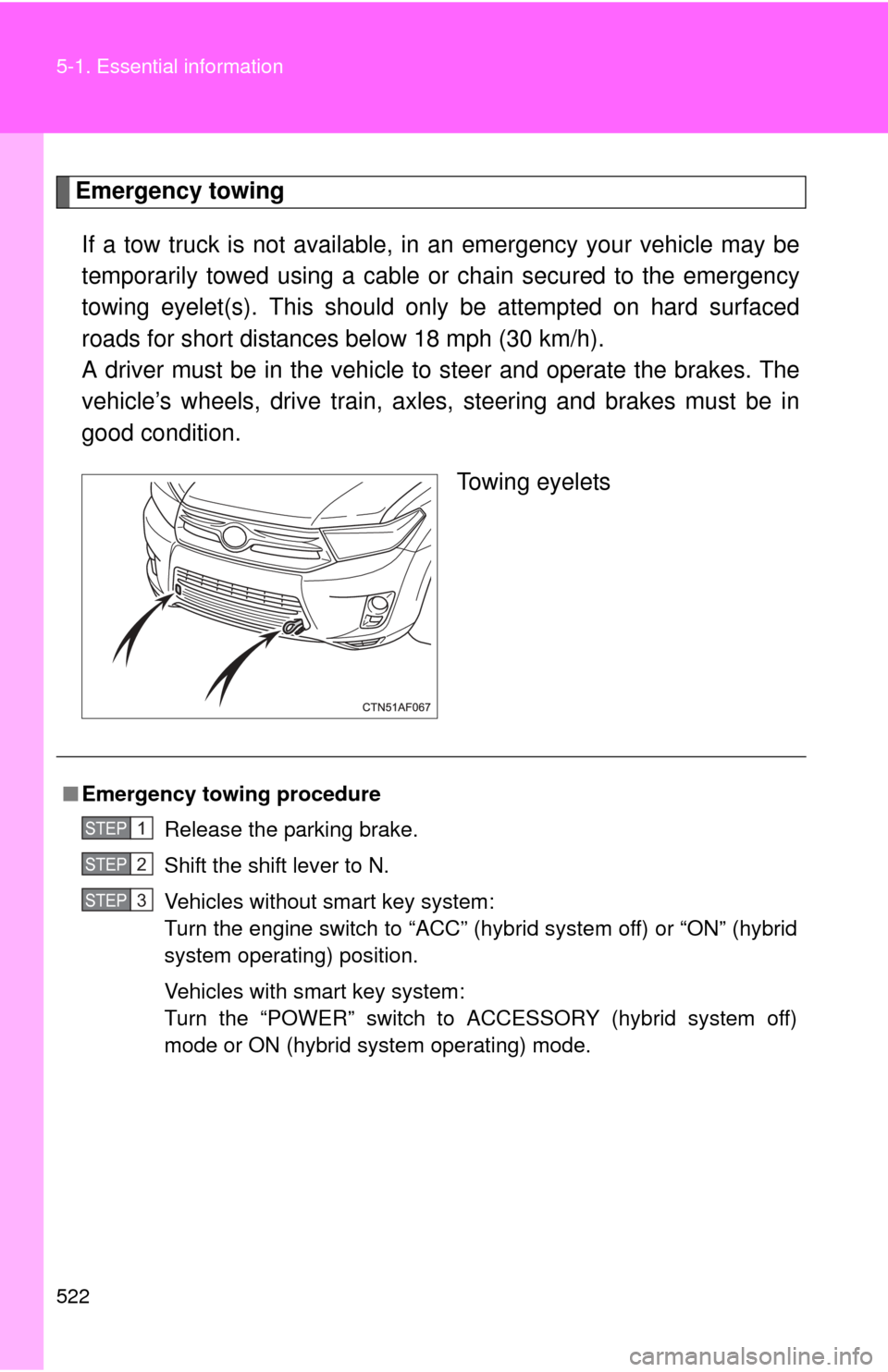
522 5-1. Essential information
Emergency towingIf a tow truck is not available, in an emergency your vehicle may be
temporarily towed using a cable or chain secured to the emergency
towing eyelet(s). This should only be attempted on hard surfaced
roads for short distances below 18 mph (30 km/h).
A driver must be in the vehicle to steer and operate the brakes. The
vehicle’s wheels, drive train, axles, steering and brakes must be in
good condition.
Towing eyelets
■Emergency towin g procedure
Release the parking brake.
Shift the shift lever to N.
Vehicles without smart key system:
Turn the engine switch to “ACC” (hybrid system off) or “ON” (hybrid
system operating) position.
Vehicles with smart key system:
Turn the “POWER” switch to ACCESSORY (hybrid system off)
mode or ON (hybrid system operating) mode.
STEP1
STEP2
STEP3
Page 527 of 636
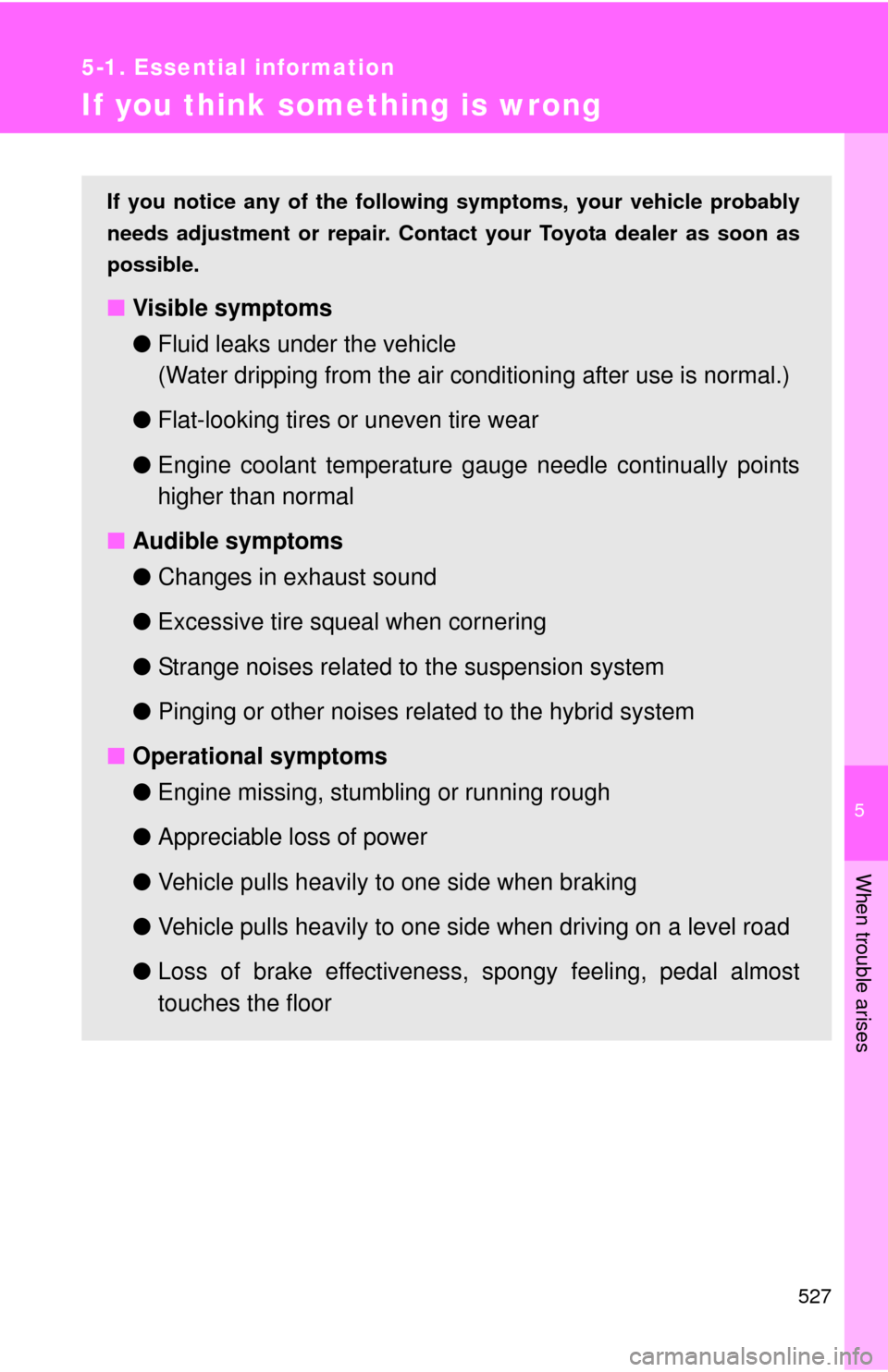
5
When trouble arises
527
5-1. Essential information
If you think something is wrong
If you notice any of the following symptoms, your vehicle probably
needs adjustment or repair. Contact your Toyota dealer as soon as
possible.
■ Visible symptoms
●Fluid leaks under the vehicle
(Water dripping from the air cond itioning after use is normal.)
● Flat-looking tires or uneven tire wear
● Engine coolant temperature g auge needle continually points
higher than normal
■ Audible symptoms
●Changes in exhaust sound
● Excessive tire squeal when cornering
● Strange noises related to the suspension system
● Pinging or other noises related to the hybrid system
■ Operational symptoms
●Engine missing, stumbling or running rough
● Appreciable loss of power
● Vehicle pulls heavily to one side when braking
● Vehicle pulls heavily to one side when driving on a level road
● Loss of brake effectiveness, s pongy feeling, pedal almost
touches the floor
Page 529 of 636

5
When trouble arises
529
5-2. Steps to take in an emergency
Stop the vehicle immediately.
The following warnings indicate the possibility of damage to the vehi-
cle that may lead to an accident. Immediately stop the vehicle in a
safe place and contact your Toyota dealer.
Have the vehicle inspected immediately.Failing to investigate the cause of the following warnings may lead to
the system operating abnormally and possibly cause an accident.
Have the vehicle inspected by your Toyota dealer immediately.
Warning lightWarning light/Details
Charging system warning light Indicates a malfunction in the vehicle’s charging system.
Warning lightWarning light/Details
(U.S.A.)
(Canada) Malfunction indicator lamp
Indicates a malfunction in:
• The hybrid system;
• The electronic engine control system;
• The electronic throttle control system; or
• The electronic transmission control system.
SRS warning light Indicates a malfunction in:
• The SRS airbag system;
• The front passenger occupant classification system; or
• The seat belt pretensioner system.
(U.S.A.)
(Canada) ABS warning light
Indicates a malfunction in:
• The ABS; or
• The brake assist system.